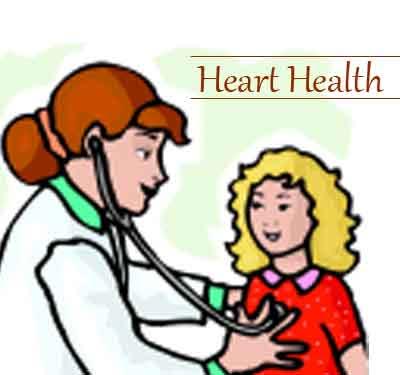- Home
- Editorial
- News
- Practice Guidelines
- Anesthesiology Guidelines
- Cancer Guidelines
- Cardiac Sciences Guidelines
- Critical Care Guidelines
- Dentistry Guidelines
- Dermatology Guidelines
- Diabetes and Endo Guidelines
- Diagnostics Guidelines
- ENT Guidelines
- Featured Practice Guidelines
- Gastroenterology Guidelines
- Geriatrics Guidelines
- Medicine Guidelines
- Nephrology Guidelines
- Neurosciences Guidelines
- Obs and Gynae Guidelines
- Ophthalmology Guidelines
- Orthopaedics Guidelines
- Paediatrics Guidelines
- Psychiatry Guidelines
- Pulmonology Guidelines
- Radiology Guidelines
- Surgery Guidelines
- Urology Guidelines
Many children's heart health not up to standards: AHA

Babies are generally born with healthy hearts that should be cared for during childhood to ensure good health later in life, according to the American Heart Association.
Yet many U.S. children don't meet seven basic standards of good heart health, the AHA says in a statement in the journal Circulation.
The standards include having a healthy weight in relation to height (body mass index, or BMI), getting enough physical activity, not smoking, following a healthy diet and maintaining healthy cholesterol, blood pressure and blood sugar levels.
"The primary reason kids fell out of cardiovascular health is diet and physical activity," said the statement's lead author Dr. Julia Steinberger, who is director of pediatric cardiology at the University of Minnesota in Minneapolis.
About 91 percent of U.S. children have poor diets, "because they're consuming sugary food and drinks," Steinberger told Reuters Health.
Only about half of young boys and a third of young girls between ages 6 and 11 are meeting the minimum recommended amount of physical activity per day of 60 minutes, according to the AHA. Those between ages 16 and 19 were even less likely to reach that goal.
"This was actually surprising even to those of us who did research in this area, even though we had an idea that lifestyle was poor," said Steinberger.
Approximately one third of U.S. adolescents report at least trying cigarettes, and that rate was slightly higher for boys than girls, she and her colleagues found.
The new statement is a companion document to one published by the AHA in 2010 about heart health in U.S. adults. That paper had a section on childhood heart health that was not very detailed, said Steinberger.
"We thought there needed to be much more detail and refinement of those metrics," she said.
The new statement says children should never try or smoke cigarettes. Their BMI should fall below the 85th percentile, and they should get at least 60 minutes of moderate to vigorous activity each day. They should have a healthy diet, maintain a total cholesterol lower than 170 milligrams per deciliter (mg/dL), blood pressure below the 90th percentile and fasting blood sugar below 100 mg/dL.
"It's very difficult to achieve this if you only target the child," said Steinberger. "It has to be a commitment of the entire family."
Schools should also be involved in promoting healthy lifestyles among children, she said.
The statement authors estimate that 10 to 27 percent of U.S. children and adolescents were obese, depending on the age group.
About a third of children and adolescents have elevated cholesterol levels, the authors say. Furthermore, about 20 percent of girls and 37 percent of boys 12 to 19 have high blood sugar.
However, blood pressure is "ideal" in about 90 percent of U.S. children and adolescents.
The statement should be a wakeup call, Steinberger said.
"If we don't take good care of our children's health, trying to implement these healthy lifestyle factors in adulthood will be extremely difficult and the yield will be a lot lower," she said.

Disclaimer: This site is primarily intended for healthcare professionals. Any content/information on this website does not replace the advice of medical and/or health professionals and should not be construed as medical/diagnostic advice/endorsement or prescription. Use of this site is subject to our terms of use, privacy policy, advertisement policy. © 2020 Minerva Medical Treatment Pvt Ltd